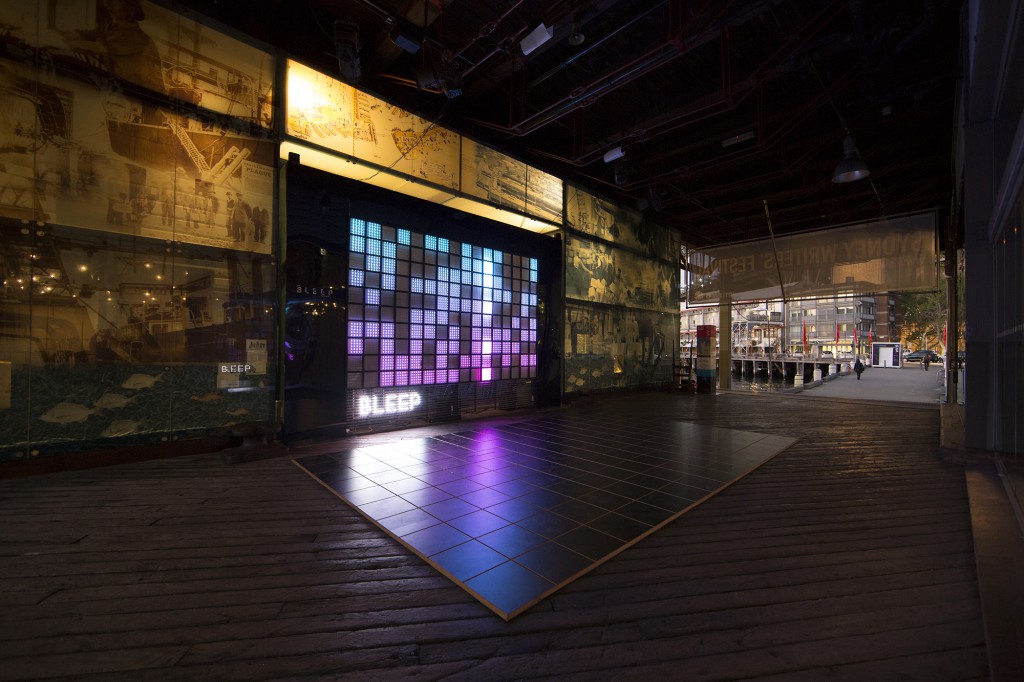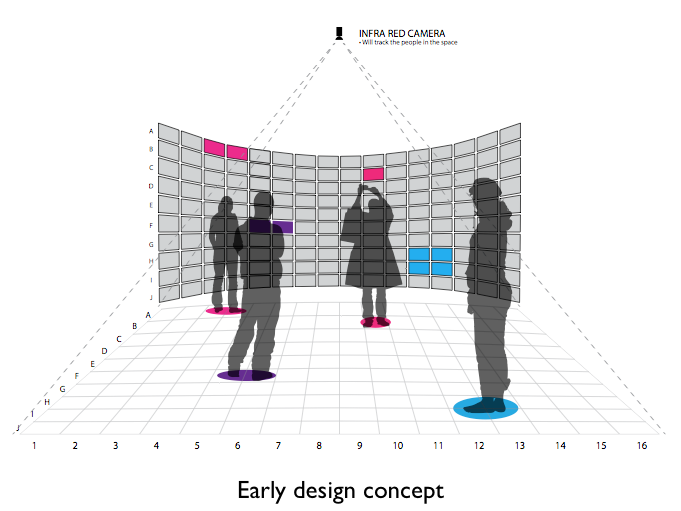Tucked in a darkened walkway between two piers under the Sydney Harbour Bridge at this years Vivid festival stood an empty dancefloor bathed in an ominous light, a gently bubbling soundtrack washing over it. This is the Bleep Sequencer, a collaboration between creative directors Toby & Pete, Liveschool students and Future Classic record label. Step onto the floor and a glowing light appears on a blackened screen. It mirrors your location, moving as you walk across the floor and creates a sound that follows you too.
What it is:
A free interactive audio-visual installation by the team who created the Flume – Infinity Prism. It is a human step-sequencer, where the movements of the crowd across a floorspace controls the composition of music in real-time – interacting with sounds by Liveschool sound-design students, as well as Flume, Charles Murdoch, LDRU, Jonny Faith, Gentleforce, Portrait and Conoley Ospovat. Every three minutes the sound palette changes and the audience explores a completely new sound-set by a different artist.

How it works:
The people in the room are tracked by an overhead camera and their position on the floor-grid is plotted on a corresponding LED screen grid. These grid positions are also the trigger for the sounds, like notes on a stave or (in electronic music) steps in a sequence. The entire setup consisted of an infra-red camera, floor grid, LED screen, a Mac mini running Ableton Live, and some small but extremely powerful HK Nano speakers. All except the screen and floor are completely hidden from view.

Sound Design challenges:
The grid consists of 10 rows of sound and 16 steps per sound, and people can literally be anywhere on that grid, and any number of people at once (or nobody) in the space. This means the musical patterns are completely random, so all the sounds need to be compatible with each other both sonically (the volumes, lengths and textures of the sounds) and harmonically (all pitches need to be able to combine well as chords). An example of a sonic solution was to make all rows the same sound – like a chime / bell sound. An example of a harmonic solution was to use a Pentatonic scale, so none of the notes will clash. Some more complex solutions involved assigning, say, 3 rows to a single sound and give each row a pitch, thereby creating a third of the board dedicated to making a bassline. There was also the challenge of repeated notes sounding irritating: how to make the sounds evolve? The exact solutions we might expand on in a future post, but we came up with some interesting innovative techniques.
Voice Stealing:
Unfortunately on the day we went to film the installation the computer had been stolen from behind the security grills, so it wasn’t running – and the only examples we can show you are from these vids we found on the interwebs.
The Sound Designers:
Future Classic artists Flume, Charles Murdoch, LDRU, Jonny Faith, Gentleforce, Portrait and Conoley Ospovat.
Liveschool students: Michael Kedzierski aka Sorcy, Scott Barnes, Brad Keane, Faizan Ali, Louis Coste & Julien Brun
Liveschool staff: Josh Panakera-Molony, Yama Indra, Adam Maggs, Rob Campbell.

Subscribe to our newsletter to keep up with our latest free tutorials, samples, video interviews and more.
Learn more about Producing Music with Ableton Live.


